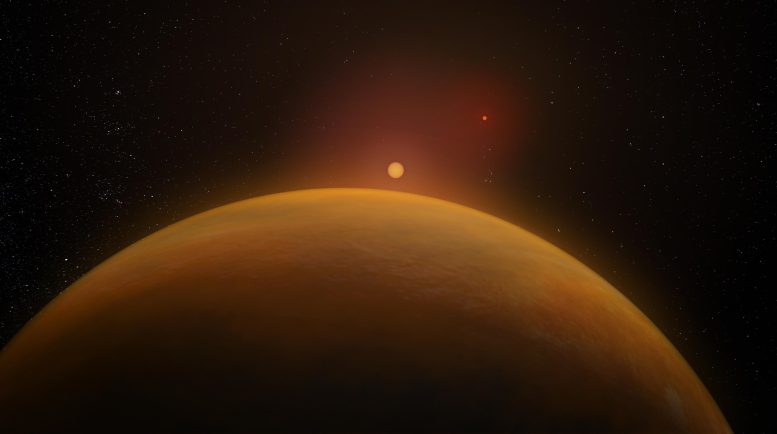Sobre un planeta de aproximadamente el doble del tamaño de Júpiter, el diseño de este artista muestra la estrella que orbita el planeta y el compañero binario de esa estrella en la distancia. Crédito: Sophia Dagnello, NRAO/AUI/NSF
Los astrónomos han descubierto un[{» attribute=»»>Jupiter-like planet orbiting a nearby star, which is one of a binary pair, by precisely tracing a small, almost imperceptible, wobble in that star’s motion through space. Their work produced the first-ever determination of the complete, 3-dimensional structure of the orbits of a binary pair of stars and a planet orbiting one of them. This achievement can provide valuable new insights into the process of planet formation, the astronomers said. This breakthrough was made using the National Science Foundation’s Very Long Baseline Array (VLBA).
Although more than 5,000 extrasolar planets have been discovered so far, only three have been discovered using a technique called astrometry, which was used to produce this discovery. However, the feat of determining the 3-D architecture of a binary-star system that includes a planet “cannot be achieved with other exoplanet discovery methods,” said Salvador Curiel, of the National Autonomous University of Mexico (UNAM).
“Since most stars are in binary or multiple systems, being able to understand systems such as this one will help us understand planet formation in general,” Curiel said.

In this artist’s conception, a small star (orange) is orbited by a Jupiter-like planet (blue), and by a more-distant companion star (red). Credit: Sophia Dagnello, NRAO/AUI/NSF
The two stars, which together are called GJ 896AB, are about 20 light-years from Earth. That makes them close neighbors of ours by astronomical standards. They are red dwarf stars, the most common type of star in our Milky Way galaxy. The larger one, around which the planet orbits, has about 44 percent of the mass of our Sun, while the smaller one is about 17 percent as massive as the Sun. They are separated by about the distance of Neptune from the Sun, and orbit each other once every 229 years.
For their study of GJ 896AB, the astronomers combined data from optical observations of the system made between 1941 and 2017 with data from VLBA observations between 2006 and 2011. They also made new VLBA observations in 2020. The continent-wide VLBA’s supersharp resolution, with its fantastic ability to see fine detail, produced extremely precise measurements of the stars’ positions over time. An extensive analysis of the data performed by the astronomers revealed the stars’ orbital motions as well as their common motion through space.
La animación del artista representa los movimientos orbitales de un par de estrellas binarias y un planeta que orbita alrededor de una de las estrellas. Crédito: Sophia Dagnello, NRAO/AUI/NSF
La existencia del planeta fue revelada por un gráfico detallado del movimiento de la estrella más grande que mostró un ligero bamboleo. El efecto gravitatorio del planeta sobre la estrella provoca el bamboleo. La estrella y el planeta orbitan entre sí en un lugar llamado baricentro, que representa su centro de masa común. Cuando esta ubicación está lo suficientemente lejos de la estrella, el movimiento de la estrella a su alrededor puede ser detectable.
Según los cálculos de los astrónomos, el planeta tiene aproximadamente el doble de la masa de Júpiter y orbita la estrella cada 284 días. Su distancia a la estrella es ligeramente menor que[{» attribute=»»>Venus’ distance from the Sun. The planet’s orbit is inclined approximately 148 degrees from the orbits of the two stars.
“This means that the planet moves around the main star in the opposite direction to that of the secondary star around the main star,” said Gisela Ortiz-León, of UNAM and the Max Planck Institute for Radioastronomy. “This is the first time that such dynamical structure has been observed in a planet associated with a compact binary system that presumably was formed in the same protoplanetary disk,” she added.
“Additional detailed studies of this and similar systems can help us gain important insights into how planets are formed in binary systems. There are alternate theories for the formation mechanism, and more data can possibly indicate which is most likely,” said Joel Sanchez-Bermudez, of UNAM. “In particular, current models indicate that such a large planet is very unlikely as a companion to such a small star, so maybe those models need to be adjusted,” he added.
The astrometric technique will be a valuable tool for characterizing more planetary systems, the astronomers said. “We can do much more work like this with the planned Next Generation VLA (ngVLA),” said Amy Mioduszewski, of the National Radio Astronomy Observatory. “With it, we may be able to find planets as small as the Earth.”
The astronomers reported their findings in the September 1 issue of the Astronomical Journal.
Reference: “3D Orbital Architecture of a Dwarf Binary System and Its Planetary Companion” by Salvador Curiel, Gisela N. Ortiz-León, Amy J. Mioduszewski and Joel Sanchez-Bermudez, 1 September 2022, Astronomical Journal.
DOI: 10.3847/1538-3881/ac7c66
The National Radio Astronomy Observatory is a facility of the National Science Foundation, operated under cooperative agreement by Associated Universities, Inc.
También te puede interesar
-
Los biólogos moleculares han descifrado el código de la formina
-
La NASA Juno ve un lago de lava liso como el cristal en la luna Io de Júpiter
-
Llame a fotógrafos y astrónomos de Wicklow para obtener fotografías extraordinarias
-
Cómo el pensamiento visuoespacial mejora la comprensión de la química | Noticias
-
La cápsula Starliner da un gran paso hacia el primer vuelo tripulado

